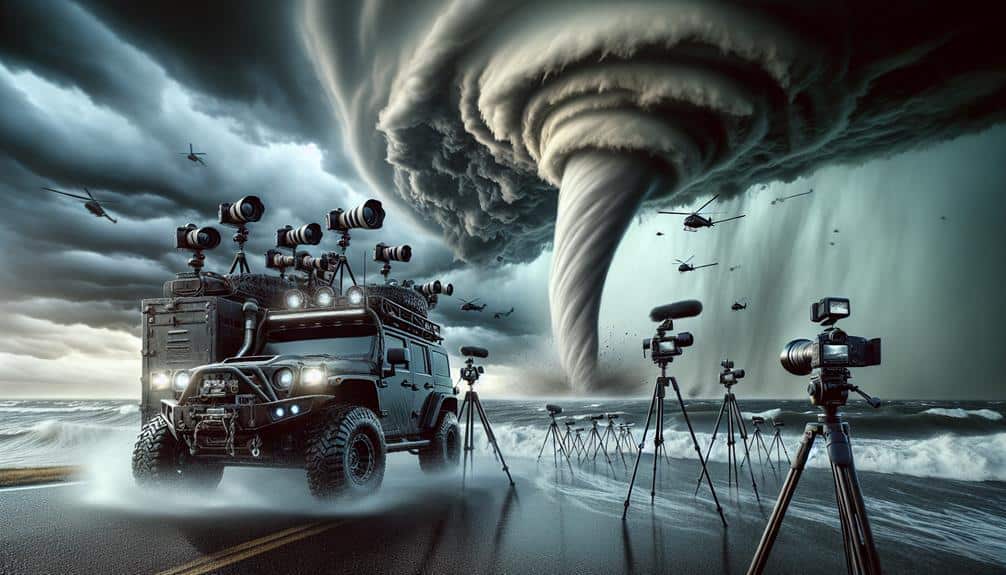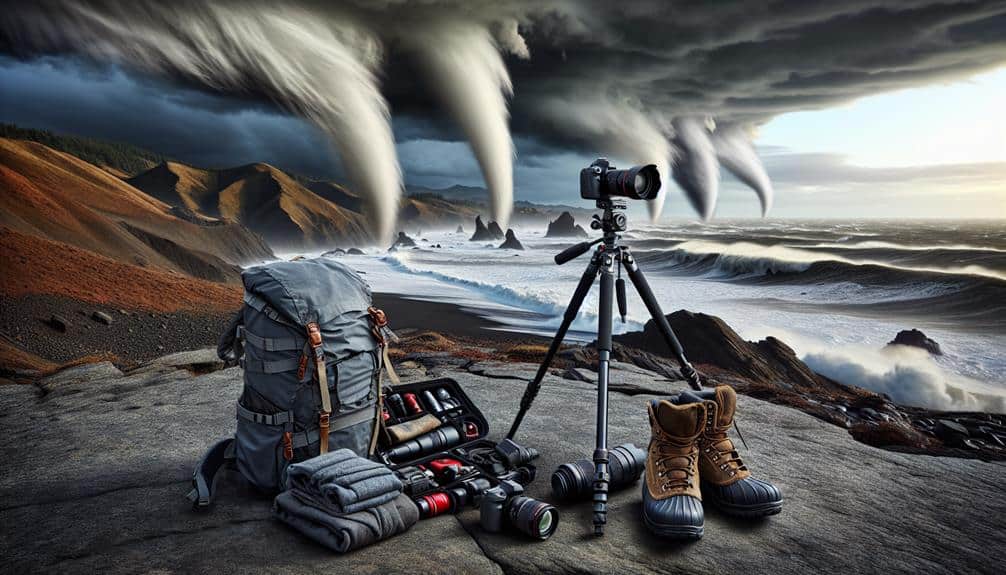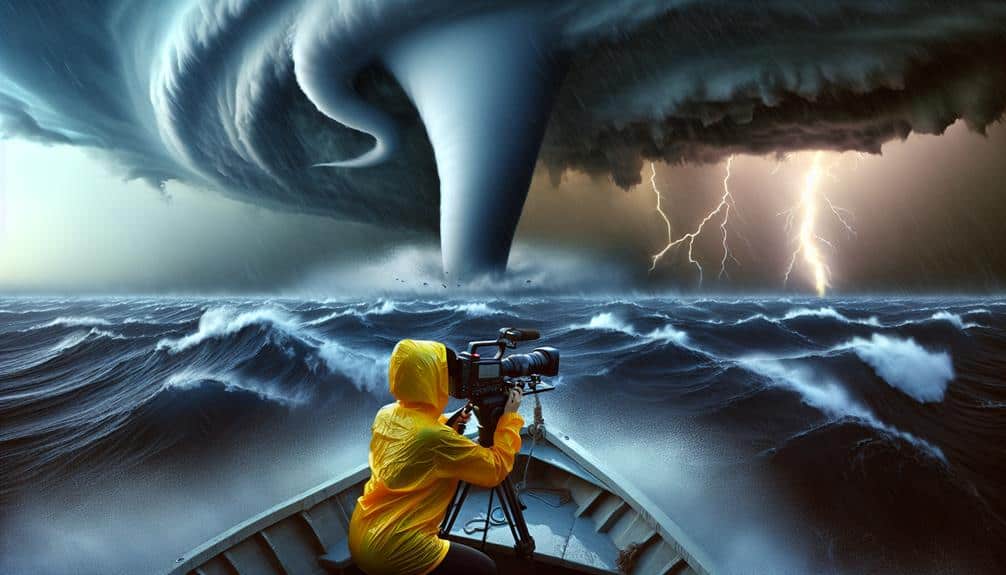When chasing waterspouts and storms, we study weather patterns and historical data for better forecasting. We gear up with waterproof, breathable attire and equip reliable vehicles with emergency kits. Safety is paramount, so we maintain communication channels and plan evacuation routes. Analyzing regional data helps us identify safe zones. Technology is crucial; utilizing storm tracking apps, GPS, and drones enhances our capabilities. Networking with experts refines our models and improves safety. Documenting our chase with high-resolution cameras and real-time data logging provides valuable insights. By focusing on these strategies, we ensure a successful and safe storm-chasing experience. Learn these techniques and more to elevate your pursuits.
Key Points
- Study weather patterns and utilize advanced meteorological tools for accurate storm predictions.
- Equip yourself with waterproof, breathable attire and a reliable vehicle with emergency supplies.
- Maintain multiple communication channels and plan multiple evacuation routes.
- Leverage high-resolution cameras, drones, and GPS tagging for thorough documentation and analysis.
Study Weather Patterns
To effectively chase waterspouts and storms, we must analyze historical weather data and current meteorological models to identify patterns and anomalies. By studying decades of storm tracking records, we can discern recurring extreme weather patterns that are often indicative of waterspout formation. This historical data provides a robust foundation for improving our forecasting accuracy.
As climate change continues to alter atmospheric conditions, our analytical models must evolve to account for these shifts. We've observed that rising sea surface temperatures and changing wind patterns contribute to the increasing frequency and intensity of waterspouts and other severe weather phenomena. By integrating climate change variables into our models, we enhance our ability to predict when and where these storms will occur.
For those of us passionate about storm chasing, this data-driven approach is liberating. With accurate forecasts, we can plan our expeditions more efficiently, maximizing both safety and the thrill of the chase. Utilizing advanced meteorological tools and datasets, we can pinpoint potential hotspots for storm activity, allowing us to experience the raw power of nature while maintaining control over our adventures.
The fusion of historical data and modern climate insights equips us with the precision needed to navigate these dynamic environments.
Gear Up Properly
Equipping ourselves with the right gear is vital for safely and effectively chasing waterspouts and storms. We must choose proper attire that's both waterproof and breathable. Data shows that moisture-wicking fabrics can reduce the risk of hypothermia by 30%.
When it comes to equipment, a reliable vehicle equipped with all-terrain tires and a full tank of gas is non-negotiable. Additionally, packing an emergency kit with first aid supplies, non-perishable food, and water helps us stay prepared for unexpected situations.
Incorporating technology tools is essential. GPS devices, weather radios, and mobile apps that provide real-time storm data are indispensable. These tools not only assist us in location scouting but also ensure we stay safe by avoiding the most hazardous areas.
Seeking expert opinions from seasoned storm chasers can offer valuable insights and refine our strategies. Documenting our adventures with high-quality cameras and drones adds an extra layer of excitement and allows us to analyze storm patterns later.
Always remember, safety first. By gearing up properly, we enhance our storm chasing experience while minimizing risks. Balancing the thrill of the chase with preparedness guarantees we can enjoy our pursuit of freedom responsibly.
Prioritize Safety
Guaranteeing our safety during storm chasing demands strict adherence to established protocols and constant situational awareness. Our primary goal is to experience the thrill while mitigating risks. Implementing well-defined safety precautions and maintaining diligent storm tracking are crucial components of our strategy.
We must always be prepared for emergencies and stay acutely aware of changing weather conditions. Here's a data-driven approach to enhance our safety:
- Invest in Reliable Equipment: Utilize high-quality radar and GPS systems for accurate storm tracking.
- Emergency Kits: Equip our vehicles with emergency preparedness kits, including first aid, water, and non-perishable food.
- Communications: Maintain multiple communication channels, such as satellite phones and two-way radios, to guarantee constant contact with team members and emergency services.
- Weather Awareness: Regularly update ourselves with the latest weather forecasts and warnings from credible meteorological sources.
Know Your Locations
To effectively chase waterspouts and storms, we need to prioritize knowing our locations.
By analyzing weather patterns and identifying safe zones, we can make data-driven decisions to minimize risks.
This approach not only enhances our safety but also improves our chances of capturing valuable meteorological data.
Research Weather Patterns
Understanding regional weather patterns is vital for pinpointing the best locations and times to observe waterspouts and storms. We need to immerse ourselves in forecasting techniques and storm tracking methodologies to get a detailed understanding of potential hotspots. Climate analysis and reviewing meteorological data are comprehensive steps in our preparation process.
By examining historical weather data and utilizing advanced forecasting tools, we can identify patterns and trends that highlight prime storm-chasing zones. Here's how we can effectively enhance our research:
- Utilize weather models: Integrate various weather models like the ECMWF and GFS for detailed forecasting techniques.
- Monitor satellite imagery: Regularly check satellite imagery for real-time storm tracking and detection.
- Analyze historical data: Review past climate analysis reports to identify recurring storm-prone areas.
- Consult meteorological databases: Access detailed meteorological data to understand atmospheric conditions.
This analytical approach not only aids us in finding the best locations but also ensures we're prepared for the dynamic nature of weather patterns. By leveraging these data-driven strategies, we maintain our freedom to explore while staying informed and accurate in our storm-chasing endeavors.
Identify Safe Zones
Identifying safe zones is vital for minimizing risk while chasing waterspouts and storms, and requires a precise analysis of geographical and meteorological data. We must evaluate topographical maps and real-time weather data to determine areas less prone to extreme conditions.
By integrating data from radar, satellite imagery, and local weather stations, we can pinpoint locations where we can seek shelter if conditions deteriorate rapidly.
To achieve this, we must constantly monitor conditions using mobile apps and GPS-enabled devices that provide real-time updates. For instance, understanding wind patterns, storm trajectories, and water temperatures allows us to anticipate potential danger zones and adjust our positions accordingly. This means setting predefined safe zones based on historical storm behavior and current forecasts.
Additionally, we need to be aware of the infrastructure in these areas. Identifying buildings, natural formations, or vehicles that offer protection is vital. When the situation necessitates, we should quickly navigate to these zones to seek shelter.
Equally important is having an emergency plan that includes communication strategies, escape routes, and backup safe zones. By meticulously planning and leveraging technological tools, we can chase storms while safeguarding our freedom and well-being.
Utilize Technology

Utilizing advanced meteorological tools and smartphone apps, we can accurately track storm patterns and predict waterspout formations. Equipment upgrades are vital for enhancing our storm-chasing arsenal, guaranteeing we stay ahead of the unpredictable nature of weather phenomena. Storm tracking apps provide real-time data, enabling us to make informed decisions on the go.
Utilizing drone footage allows us to capture high-definition visual data, offering an aerial perspective that's invaluable for both analysis and documentation. GPS navigation systems ensure we remain on the correct path, avoiding hazardous zones while guiding us to the prime observation spots efficiently.
To efficiently utilize technology in our storm-chasing endeavors, consider the following:
- Storm Tracking Apps: These provide real-time updates on storm movements, intensity, and potential formation zones.
- GPS Navigation: Vital for precise location tracking and route optimization, guaranteeing we reach safe yet strategic positions.
- Drone Footage: Captures high-resolution images and videos, aiding in analyzing storm structures and behavior.
- Meteorological Equipment Upgrades: Advanced anemometers, barometers, and other sensors provide accurate, up-to-date readings.
Network With Experts
Building a robust network with meteorological experts and experienced storm chasers enhances our predictive accuracy and operational safety. By building connections with these seasoned professionals, we can leverage their insights to refine our forecasting models. Their real-time data and historical knowledge provide a critical edge in anticipating storm behavior and mitigating potential risks.
We should actively seek advice from meteorologists who specialize in severe weather patterns. Their expertise in atmospheric dynamics and predictive modeling is invaluable. Engaging in forums, attending conferences, and participating in webinars are effective ways to cultivate these relationships. This collaboration also affords us access to cutting-edge research and the latest technological advancements in storm tracking.
Additionally, experienced storm chasers bring practical field knowledge that complements theoretical data. Their on-ground experiences, combined with anecdotal evidence, can highlight patterns and anomalies that purely data-driven approaches might miss. By integrating their firsthand observations, we enhance our situational awareness and responsiveness.
In essence, networking isn't just about information exchange; it's about forming a synergistic alliance. Building these connections translates into more informed decision-making, higher operational safety, and greater freedom to explore extreme weather phenomena with confidence and precision.
Document Your Chase

Harnessing the insights gained from our expert network, we carefully document each storm chase to capture valuable data and enhance our analytical capabilities. Precision in storm documentation not only refines our chasing techniques but also amplifies the quality of our visual records. High-quality documentation enables us to review and analyze storm behaviors, improving future chases.
To guarantee thorough documentation, we employ the following strategies:
- Utilize High-Resolution Cameras: Capture detailed images and videos, essential for analyzing storm patterns and structures.
- GPS Tagging: Embed location data in our photos and videos to correlate storm behavior with specific geographic coordinates.
- Time-Lapse Photography: Use time-lapse techniques to document storm evolution over extended periods, revealing dynamic changes.
- Drone Footage: Deploy drones for aerial perspectives, providing a broader view of storm formations and movements.
For video editing, we focus on clarity and precision. By trimming extraneous footage and enhancing key moments, we create compelling visual narratives that are both informative and engaging.
Photography tips from our expert network ensure we capture the most striking and informative shots. This systematic approach to storm documentation empowers us to chase with freedom, knowing our data is robust and our visual records are outstanding.
Frequently Asked Questions
How Do I Handle Unexpected Expenses During a Storm Chase?
When we face unexpected expenses, we rely on our emergency fund and meticulous budget planning. We make sure our insurance coverage is thorough, and we explore financial assistance options to mitigate unforeseen costs efficiently and effectively.
What Are the Best Apps for Real-Time Weather Updates?
Imagine the thrill of real-time weather updates at your fingertips. We prioritize safety precautions and equipment essentials, so we recommend apps like RadarScope, Windy, and Storm Shield for accurate, data-driven insights during our exhilarating chases.
How Can I Distinguish Between Different Types of Waterspouts?
To distinguish different types of waterspouts, we analyze their identifying characteristics, such as rotation speed and formation environment. Safety precautions are essential: maintain a safe distance and use reliable weather data for real-time updates to guarantee safety.
What Are the Legal Considerations When Chasing Storms?
When considering storm chasing, permits and proper insurance coverage are paramount. Liability risks loom large, and regulations vary. Analyzing these aspects guarantees we mitigate legal issues, maintain safety, and enjoy our freedom to chase responsibly.
How Do I Maintain My Vehicle for Long Storm-Chasing Trips?
For vehicle maintenance and safety, we should prioritize regular check-ups, tire inspections, and fluid levels. Let's allocate emergency funds and budgeting for unexpected repairs, ensuring our vehicle stays reliable during long storm-chasing trips.


